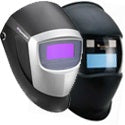WELDING PPE
Personal Protective Equipment for Welding and Cutting
What is PPE, and why do I need it?
Many hazards are present in welding such as sparks, spatter, slag, heat, fumes, radiation and even electric shock. The use of Personal Protective Equipment including welding helmets, gloves, jackets and respirators is required by regulatory agencies such as OSHA to prevent job-related injuries or death.

Head and Face Protection:Welding helmets protect the face, forehead, neck and ears from the direct radiant energy from the arc and direct spatter, and protect eyes from UV glare. The helmet must have the appropriate shade (darkness) for the type of welding being performed. Cutting and grinding require shade 3-5, whereas MIG and TIG welding require shades 9-12. Plasma and arc welding require the darkest shades (12-14). Safety goggles should be worn under the helmet to protect against flying metal, slag, metal fragments, and other debris that can ricochet under the helmet. Earplugs or earmuffs should be worn to prevent hearing loss and also to keep flying debris out of the ear canals. A welder's cap or other fire resistant head covering should be worn under your helmet to protect from sparks, spatter and radiation burns.
Protective Clothing: Welding jackets, aprons, and sleeves protect your skin and clothing from sparks, slag and radiation burns. Flame resistant cotton, Nomex and leather are the most common materials for welding jackets. Jackets should always be buttoned up to the collar, and fit as tight as possible, while still allowing for full range of motion. Loose or baggy clothing can result in burns. Women should not try to wear men's welding gear, as it will not fit properly. Do not wear synthetic fabrics when welding, as they can burn and melt onto skin. A leather apron over a welding jacket adds an extra layer of insulation and protection.
Welding Gloves: There are different styles of welding gloves to protect against the varrying hazards of different types of welding. MIG welding gloves are generally thick and tough. TIG welding gloves are thinner and provide more dexterity. General welding gloves are usually made of padded leather, and offer appropriate protection for most welding applications. Gauntlet gloves offer extra protection for the forearm. Welding jackets should be tucked into gloves whenever possible to prevent exposed skin from getting burned. For best results, gloves should be kept clean and dry, and free of holes and fraying.
Foot Protection: Leather, steel toe boots with high tops are recommended for all welding applications. Pants should be tucked into boots, covering all exposed skin to prevent sparks from flying in. In heavy spark or slag environments, leather spats may be required over boots for extra protection. Heavy tread with non-skid or slip resistant soles are preferable.
Respiratory Protection: Dangerous fumes can be present in several types of welding, and respirators may need to be worn occasionally. Disposable particulate resiprators are an economical choice for mild fume exposure, and fit easily underneath a welding helmet. Reuseable half-facepiece respirators provide lasting protection with changeable filters. The light weight, low profile design fits underneath most welding helmets. For heavy fumes in confined spaces, a special welding PAPR (Powered Air Purifying Respirator) may be required.
